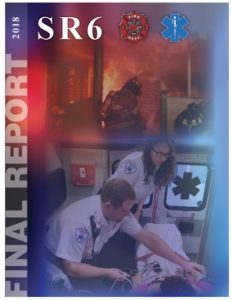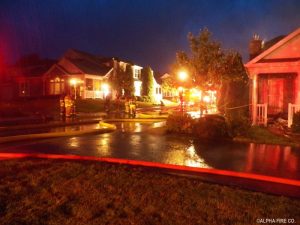The Smoke In The Distance
July 5, 2019
Challenges Facing PA Fire & Emergency Response Services.
In a blog about six months ago, we talked about a four-alarm fire facing volunteer fire departments at the state level with
a brief review of the Senate Resolution 6 Report (SR6) in Pennsylvania. The primary takeaway? While volunteerism on the whole has decreased dramatically over the last 30 years, the raw expenses and job responsibilities of first response have grown exponentially.

These facts (among others) chart an unsustainable course for many volunteer fire departments and fire stations across the state.
Some stations have an aging base of volunteers that haven’t been replaced due to demographic shifts. Some stations have outdated equipment that no charity boot drive or 4th of July fundraiser can offset. Some stations just don’t have enough people. And as responsibilities grow and coverage areas expand, so too does the need for our communities to employ truly full-time firefighters and emergency responders.
But as you’ll see in this discussion with Jerry Ozog, Executive Director of the
Pennsylvania Fire and Emergency Services Institute, there’s plenty that can be done so long as municipalities, governing bodies and fire department leadership all keep their cool and take on the challenges together.
Harrisburg’s Not Going To Solve The Problem.
That’s the long and short of the story shared by Mr. Ozog, himself a 33-year veteran of emergency services (
fire and EMT), professional education (
12 years as Director of Fire Training at Harrisburg Area Community College), as and a Deputy Chief in the HamdenTownship Volunteer Fire Department.
 “Here are the facts: Cost of operations for emergency response is going up, especially since we’re tasked with doing more than ever before. Revenue streams aren’t keeping pace with costs at all—barbecues and boot drives do awesome things, but they can’t pay for a half-million dollar engine. And community interest and the ability to join emergency response as an unpaid or underpaid volunteer has dropped exponentially over the last 30 years,” Ozog said.
“Here are the facts: Cost of operations for emergency response is going up, especially since we’re tasked with doing more than ever before. Revenue streams aren’t keeping pace with costs at all—barbecues and boot drives do awesome things, but they can’t pay for a half-million dollar engine. And community interest and the ability to join emergency response as an unpaid or underpaid volunteer has dropped exponentially over the last 30 years,” Ozog said.
Taken separately, any of these challenges represents a threat to the current model of dozens upon dozens of smaller volunteer departments scraping by to provide more and more services for their individual regions.
But when taken together, there’s a looming crisis on the horizon that can only be solved by municipal and departmental transparency, cooperation, and yes, in many instances, consolidation.
Because The Times, They Are A Changin’.
It’s time to face the facts on the ground across the state, particularly in rural communities as populations shift and tax bases change.
“Here’s the thing that’s most important to remember—regionalization and consolidation does not have to mean closing fire stations,” Ozog said.
“But it does mean that local, county and state government need to come to the table with fire department leadership at all levels to form a plan of attack that keeps the community safe, provides necessary levels of emergency response to all areas, and hammers out ways to pay for it all.
That might mean new taxes. That might mean increased state contributions. That might mean creating more full time emergency response jobs. And yes, that might mean pooling existing resources and consolidating departments regionally, while striving to preserve and maintain individual stations.”
And that’s why Ozog and his team at the PSEI has prepared an action blueprint and seminar that he delivers in person anywhere in the state.

Because while there is no “one size fits all” solution to the problem of funding and manpower shortages, an aging personnel base, and local/regional pride in preservation of existing fire stations—there is overwhelming evidence that doing nothing means some departments are going to go completely under—threatening the safety and well being of disparate communities all across Pennsylvania.
“There are certain places that have gone a long way to solve this challenge with aggressive partnership with regional governing bodies, but places like State College and Pittsburgh and Philadelphia also have the advantage of a solid tax base as well as a critical mass of potential recruits on which to draw upon for volunteer services.” Ozog added.
It’s Time To Have The Tough Conversations.
Ozog is quick to point out that pride isn’t going to solve the problem. And facing the structural and fiscal reality of sustaining world-class fire and emergency services for Pennsylvania means that everyone has to come to the table prepared to compromise for the greater good.
 “Many of our regions aren’t as fortunate as Alpha’s. Their people are getting older without being replaced. Their equipment is falling behind. So it’s time to come to the table together – department leaders, station chiefs, municipal leaders, and government officials, to figure something out. Everyone’s going to have to give something up.
What’s going to work in Scranton may not work in Westmoreland County. My organization promotes local, county and state level cooperation. The solution is truly working together so regions recognize the problems they face, and develop solutions that keep emergency services whole and effective for a region.”
“Many of our regions aren’t as fortunate as Alpha’s. Their people are getting older without being replaced. Their equipment is falling behind. So it’s time to come to the table together – department leaders, station chiefs, municipal leaders, and government officials, to figure something out. Everyone’s going to have to give something up.
What’s going to work in Scranton may not work in Westmoreland County. My organization promotes local, county and state level cooperation. The solution is truly working together so regions recognize the problems they face, and develop solutions that keep emergency services whole and effective for a region.”
The alarm bell is still sounding, in other words. And across the state, sooner or later we’re all going to have to answer the call.
To learn more about this pressing issue, please see perspectives from two different regions …
Cumberland County Kittanning (
also includes video interview)
To reach out to Jerry directly and to learn more, visit the Pennsylvania Fire and Emergency Services Institute website.
Connect with
Jerry Ozog on LinkedIn here.
 These facts (among others) chart an unsustainable course for many volunteer fire departments and fire stations across the state.
Some stations have an aging base of volunteers that haven’t been replaced due to demographic shifts. Some stations have outdated equipment that no charity boot drive or 4th of July fundraiser can offset. Some stations just don’t have enough people. And as responsibilities grow and coverage areas expand, so too does the need for our communities to employ truly full-time firefighters and emergency responders.
But as you’ll see in this discussion with Jerry Ozog, Executive Director of the Pennsylvania Fire and Emergency Services Institute, there’s plenty that can be done so long as municipalities, governing bodies and fire department leadership all keep their cool and take on the challenges together.
These facts (among others) chart an unsustainable course for many volunteer fire departments and fire stations across the state.
Some stations have an aging base of volunteers that haven’t been replaced due to demographic shifts. Some stations have outdated equipment that no charity boot drive or 4th of July fundraiser can offset. Some stations just don’t have enough people. And as responsibilities grow and coverage areas expand, so too does the need for our communities to employ truly full-time firefighters and emergency responders.
But as you’ll see in this discussion with Jerry Ozog, Executive Director of the Pennsylvania Fire and Emergency Services Institute, there’s plenty that can be done so long as municipalities, governing bodies and fire department leadership all keep their cool and take on the challenges together.
“Here are the facts: Cost of operations for emergency response is going up, especially since we’re tasked with doing more than ever before. Revenue streams aren’t keeping pace with costs at all—barbecues and boot drives do awesome things, but they can’t pay for a half-million dollar engine. And community interest and the ability to join emergency response as an unpaid or underpaid volunteer has dropped exponentially over the last 30 years,” Ozog said.
 Because while there is no “one size fits all” solution to the problem of funding and manpower shortages, an aging personnel base, and local/regional pride in preservation of existing fire stations—there is overwhelming evidence that doing nothing means some departments are going to go completely under—threatening the safety and well being of disparate communities all across Pennsylvania.
“There are certain places that have gone a long way to solve this challenge with aggressive partnership with regional governing bodies, but places like State College and Pittsburgh and Philadelphia also have the advantage of a solid tax base as well as a critical mass of potential recruits on which to draw upon for volunteer services.” Ozog added.
Because while there is no “one size fits all” solution to the problem of funding and manpower shortages, an aging personnel base, and local/regional pride in preservation of existing fire stations—there is overwhelming evidence that doing nothing means some departments are going to go completely under—threatening the safety and well being of disparate communities all across Pennsylvania.
“There are certain places that have gone a long way to solve this challenge with aggressive partnership with regional governing bodies, but places like State College and Pittsburgh and Philadelphia also have the advantage of a solid tax base as well as a critical mass of potential recruits on which to draw upon for volunteer services.” Ozog added.
 “Many of our regions aren’t as fortunate as Alpha’s. Their people are getting older without being replaced. Their equipment is falling behind. So it’s time to come to the table together – department leaders, station chiefs, municipal leaders, and government officials, to figure something out. Everyone’s going to have to give something up.
What’s going to work in Scranton may not work in Westmoreland County. My organization promotes local, county and state level cooperation. The solution is truly working together so regions recognize the problems they face, and develop solutions that keep emergency services whole and effective for a region.”
The alarm bell is still sounding, in other words. And across the state, sooner or later we’re all going to have to answer the call.
To learn more about this pressing issue, please see perspectives from two different regions …
Cumberland County Kittanning (also includes video interview)
To reach out to Jerry directly and to learn more, visit the Pennsylvania Fire and Emergency Services Institute website.
Connect with Jerry Ozog on LinkedIn here.
“Many of our regions aren’t as fortunate as Alpha’s. Their people are getting older without being replaced. Their equipment is falling behind. So it’s time to come to the table together – department leaders, station chiefs, municipal leaders, and government officials, to figure something out. Everyone’s going to have to give something up.
What’s going to work in Scranton may not work in Westmoreland County. My organization promotes local, county and state level cooperation. The solution is truly working together so regions recognize the problems they face, and develop solutions that keep emergency services whole and effective for a region.”
The alarm bell is still sounding, in other words. And across the state, sooner or later we’re all going to have to answer the call.
To learn more about this pressing issue, please see perspectives from two different regions …
Cumberland County Kittanning (also includes video interview)
To reach out to Jerry directly and to learn more, visit the Pennsylvania Fire and Emergency Services Institute website.
Connect with Jerry Ozog on LinkedIn here.